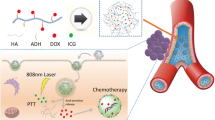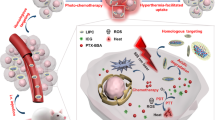Abstract
Purpose
The aim of this study was to design hyaluronic acid (HA) layer-by-layer (LbL) nanoparticles, which carried paclitaxel (PTX) and Indocyanine green (ICG) to both tumor cells and tumor associated cells to achieve synergistic chemo-photothermal therapeutic effect.
Methods
The LbL-engineered nanoparticles (PDIH) were prepared by dopamine self-polymerization on PTX nanocrystal to form thin, surface-adherent polydopamine (PDA) films, which subsequently absorbed ICG and HA. The tumor cell and tumor associated cell targeting and antitumor efficacy of PDIH were investigated both in vitro an in vivo using 4 T1 murine mammary cancer cell lines and mice bearing orthotopic 4 T1 breast tumor.
Results
PDIH presented a long-rod shape in TEM and showed enhanced photothermal effect and cytotoxicity upon NIR laser irradiation both in vitro and in vivo. PDIH also displayed high target ability to CD44 overexpressed tumor cells and tumor associated cells mediated by HA. In vivo antitumor study indicated that PDIH therapeutic strategy could achieve remarkable antitumor efficacy.
Conclusion
PDIH showed excellent tumor-targeting property and chemo-photothermal therapeutic efficacy.








Similar content being viewed by others
Abbreviations
- CLSM:
-
Confocal laser scan microscopy
- FDA:
-
The US food and drug administration
- FITC:
-
Fluorescein-5(6)-isothiocyanate
- HA:
-
Hyaluronic acid
- ICG:
-
Indocyanine green
- LbL:
-
Layer-by-layer
- MTT:
-
Methyl thiazolyl tetrazolium
- NIR:
-
Near infrared
- PAI:
-
Photoacoustic imaging
- PDA:
-
Polydopamine
- PTX:
-
Paclitaxel
- TAF:
-
Tumor associated fibroblast
- TAM:
-
Tumor associated macrophage
- TEM:
-
Transmission electron microscopy
Rererences
Siegel RL, Miller KD, Jemal A. Cancer statistics, 2015. CA Cancer J Clin. 2015;65(1):5–29.
Cao J, Chen D, Huang SS, Deng DW, Tang LP, Gu YQ. Multifunctional near-infrared light-triggered biodegradable micelles for chemo-and photo-thermal combination therapy. Oncotarget. 2016;7(50):82170–84.
Peer D, Karp JM, Hong S, FaroKHzad OC, Margalit R, Langer R. Nanocarriers as an emerging platform for cancer therapy. Nat Nanotechnol. 2007;2(12):751–60.
Zheng M, Yue C, Ma Y, Gong P, Zhao P, Zheng C, et al. Single-step assembly of DOX/ICG loaded lipid--polymer nanoparticles for highly effective chemo-photothermal combination therapy. ACS Nano. 2013;7(3):2056–67.
Chen Y, Li H, Deng Y, Sun H, Ke X, Ci T. Near-infrared light triggered drug delivery system for higher efficacy of combined chemo-photothermal treatment. Acta Biomater. 2017;51:374–92.
Zhang L, Su H, Cai J, Cheng D, Ma Y, Zhang J, et al. A multifunctional platform for tumor angiogenesis-targeted chemo-thermal therapy using polydopamine-coated gold nanorods. ACS Nano. 2016;10(11):10404–17.
Zhao L, Yuan W, Tham HP, Chen H, Xing P, Xiang H, et al. Fast-clearable nanocarriers conducting chemo/photothermal combination therapy to inhibit recurrence of malignant tumors. Small. 2017;13(29)
Li N, Li TT, Hu C, Lei XM, Zuo YP, Han HY. Targeted near-infrared fluorescent turn-on nanoprobe for activatable imaging and effective phototherapy of cancer cells. ACS Appl Mater Interfaces. 2016;8(24):15013–23.
Sherlock SP, Tabakman SM, Xie LM, Dai HJ. Photothermally enhanced drug delivery by ultrasmall multifunctional FeCo/graphitic shell nanocrystals. ACS Nano. 2011;5(2):1505–12.
Zhang ZJ, Wang LM, Wang J, Jiang XM, Li XH, Hu ZJ, et al. Mesoporous silica-coated gold nanorods as a light-mediated multifunctional theranostic platform for cancer treatment. Adv Mater. 2012;24(11):1418–23.
Wang Y, Wang KY, Zhao JF, Liu XG, Bu J, Yan XY, et al. Multifunctional mesoporous silica-coated graphene nanosheet used for chemo-photothermal synergistic targeted therapy of glioma. J Am Chem Soc. 2013;135(12):4799–804.
Cheng L, Wang C, Feng LZ, Yang K, Liu Z. Functional nanomaterials for phototherapies of cancer. Chem Rev. 2014;114(21):10869–939.
Nel A, Xia T, Madler L, Li N. Toxic potential of materials at the nanolevel. Science. 2006;311(5761):622–7.
Shemesh CS, Moshkelani D, Zhang HL. Thermosensitive liposome formulated indocyanine green for near-infrared triggered photodynamic therapy: in vivo evaluation for triple-negative breast cancer. Pharm Res-Dordr. 2015;32(5):1604–14.
Deng ZJ, Morton SW, Ben-Akiva E, Dreaden EC, Shopsowitz KE, Hammond PT. Layer-by-layer nanoparticles for systemic codelivery of an anticancer drug and siRNA for potential triple-negative breast cancer treatment. ACS Nano. 2013;7(11):9571–84.
Minchinton AI, Tannock IF. Drug penetration in solid tumours. Nat Rev Cancer. 2006;6(8):583–92.
Singh Y, Palombo M, Sinko PJ. Recent trends in targeted anticancer prodrug and conjugate design. Curr Med Chem. 2008;15(18):1802–26.
Wen R, Banik B, Pathak RK, Kumar A, Kolishetti N, Dhar S. Nanotechnology inspired tools for mitochondrial dysfunction related diseases. Adv Drug Deliv Rev. 2016;99:52–69.
Ming Y, Li Y, Xing H, Luo M, Li Z, Chen J, et al. Circulating tumor cells: from theory to nanotechnology-based detection. Front Pharmacol. 2017;8:35.
Hida K, Ishii G. Editorial: Targeting tumor microenvironment heterogeneity. Adv Drug Deliv Rev. 2016;99(Pt B):139.
Huang WC, Chen SH, Chiang WH, Huang CW, Lo CL, Chern CS, et al. Tumor microenvironment-responsive nanoparticle delivery of chemotherapy for enhanced selective cellular uptake and transportation within tumor. Biomacromolecules. 2016;17(12):3883–92.
Reisfeld RA. The tumor microenvironment: a target for combination therapy of breast cancer. Crit Rev Oncog. 2013;18(1–2):115–33.
De Palma M, Lewis CE. Macrophage regulation of tumor responses to anticancer therapies. Cancer Cell. 2013;23(3):277–86.
Qian BZ, Pollard JW. Macrophage diversity enhances tumor progression and metastasis. Cell. 2010;141(1):39–51.
Chen BL, Dai WB, Mei D, Liua TZ, Li SX, He B, et al. Comprehensively priming the tumor microenvironment by cancer-associated fibroblast-targeted liposomes for combined therapy with cancer cell-targeted chemotherapeutic drug delivery system. J Control Release. 2016;241:68–80.
Flach EH, Rebecca VW, Herlyn M, Smalley KSM, Anderson ARA. Fibroblasts contribute to melanoma tumor growth and drug resistance. Mol Pharm. 2011;8(6):2039–49.
Song ML, Liu T, Shi CR, Zhang XZ, Chen XY. Bioconjugated manganese dioxide nanoparticles enhance chemotherapy response by priming tumor-associated macrophages toward m1-like phenotype and attenuating tumor hypoxia. ACS Nano. 2016;10(1):633–47.
Kelkar SS, Hill TK, Marini FC, Mohs AM. Near infrared fluorescent nanoparticles based on hyaluronic acid: self-assembly, optical properties, and cell interaction. Acta Biomater. 2016;36:112–21.
de la Rosa JM R, Tirella A, Gennari A, Stratford IJ, Tirelli N. The CD44-mediated uptake of hyaluronic acid-based carriers in macrophages. Adv Healthc Mater. 2017;6(4)
Duff MD, Mestre J, Maddali S, Yan ZP, Stapleton P, Daly JM. Analysis of gene expression in the tumor-associated macrophage. J Surg Res. 2007;142(1):119–28.
Kinugasa Y, Matsui T, Takakura N. CD44 expressed on cancer-associated fibroblasts is a functional molecule supporting the stemness and drug resistance of malignant cancer cells in the tumor microenvironment. Stem Cells. 2014;32(1):145–56.
Qi W, Yan X, Fei J, Wang A, Cui Y, Li J. Triggered release of insulin from glucose-sensitive enzyme multilayer shells. Biomaterials. 2009;30(14):2799–806.
Decher G. Fuzzy nanoassemblies: toward layered polymeric multicomposites. Science. 1997;277(5330):1232–7.
Park J, Brust TF, Lee HJ, Lee SC, Watts VJ, Yeo Y. Polydopamine-based simple and versatile surface modification of polymeric nano drug carriers. ACS Nano. 2014;8(4):3347–56.
Lee H, Dellatore SM, Miller WM, Messersmith PB. Mussel-inspired surface chemistry for multifunctional coatings. Science. 2007;318(5849):426–30.
Dong ZL, Gong H, Gao M, Zhu WW, Sun XQ, Feng LZ, et al. Polydopamine nanoparticles as a versatile molecular loading platform to enable imaging-guided cancer combination therapy. Theranostics. 2016;6(7):1031–42.
Liu Y, Ai K, Lu L. Polydopamine and its derivative materials: synthesis and promising applications in energy, environmental, and biomedical fields. Chem Rev. 2014;114(9):5057–115.
Hu DH, Zhang JN, Gao GH, Sheng ZH, Cui HD, Cai LT. Indocyanine green-loaded polydopamine-reduced graphene oxide nanocomposites with amplifying photoacoustic and photothermal effects for cancer theranostics. Theranostics. 2016;6(7):1043–52.
Bi D, Zhao L, Yu R, Li H, Guo Y, Wang X, et al. Surface modification of doxorubicin-loaded nanoparticles based on polydopamine with pH-sensitive property for tumor targeting therapy. Drug Deliv. 2018;25(1):564–75.
Park J, Sun B, Yeo Y. Albumin-coated nanocrystals for carrier-free delivery of paclitaxel. J Control Release. 2017;263:90–101.
Liu F, Park JY, Zhang Y, Conwell C, Liu Y, Bathula SR, et al. Targeted cancer therapy with novel high drug-loading nanocrystals. J Pharm Sci. 2010;99(8):3542–51.
Deng JX, Huang L, Liu F. Understanding the structure and stability of paclitaxel nanocrystals. Int J Pharm. 2010;390(2):242–9.
Tan XX, Wang JP, Pang XJ, Liu L, Sun Q, You Q, et al. Indocyanine green-loaded silver nanoparticle@polyaniline core/shell theranostic nanocomposites for photoacoustic/near-infrared fluorescence imaging-guided and single-light-triggered photothermal and photodynamic therapy. ACS Appl Mater Interfaces. 2016;8(51):34991–5003.
Mehta SB, Carpenter JF, Randolph TW. Colloidal instability fosters agglomeration of subvisible particles created by rupture of gels of a monoclonal antibody formed at silicone oil-water interfaces. J Pharm Sci. 2016;105(8):2338–48.
Hobbs SK, Monsky WL, Yuan F, Roberts WG, Griffith L, Torchilin VP, et al. Regulation of transport pathways in tumor vessels: role of tumor type and microenvironment. P Natl Acad Sci USA. 1998;95(8):4607–12.
Chu KS, Hasan W, Rawal S, Walsh MD, Enlow EM, Luft JC, et al. Plasma, tumor and tissue pharmacokinetics of Docetaxel delivered via nanoparticles of different sizes and shapes in mice bearing SKOV-3 human ovarian carcinoma xenograft. Nanomed-Nanotechnol. 2013;9(5):686–93.
Issels RD. Hyperthermia adds to chemotherapy. Eur J Cancer. 2008;44(17):2546–54.
Altinoglu EI, Russin TJ, Kaiser JM, Barth BM, Eklund PC, Kester M, et al. Near-infrared emitting fluorophore-doped calcium phosphate nanoparticles for in vivo imaging of human breast cancer. ACS Nano. 2008;2(10):2075–84.
Wang YZ, Wang C, Ding Y, Li J, Li M, Liang X, et al. Biomimetic HDL nanoparticle mediated tumor targeted delivery of indocyanine green for enhanced photodynamic therapy. Colloid Surface B. 2016;148:533–40.
Desmettre T, Devoisselle JM, Mordon S. Fluorescence properties and metabolic features of indocyanine green (ICG) as related to angiography. Surv Ophthalmol. 2000;45(1):15–27.
Cai W, Gao HY, Chu CC, Wang XY, Wang JQ, Zhang PF, et al. Engineering phototheranostic nanoscale metal-organic frameworks for multimodal imaging-guided cancer therapy. ACS Appl Mater Interfaces. 2017;9(3):2040–51.
Wang LV, Hu S. Photoacoustic tomography: in vivo imaging from organelles to organs. Science. 2012;335(6075):1458–62.
Zeng YY, Zhang D, Wu M, Liu Y, Zhang X, Li L, et al. Lipid-AuNPs@PDA nanohybrid for MRI/CT imaging and photothermal therapy of hepatocellular carcinoma. ACS Appl Mater Interfaces. 2014;6(16):14266–77.
Stinchcombe TE, Socinski MA, Walko CM, O’Neil BH, Collichio FA, Ivanova A, et al. Phase I and pharmacokinetic trial of carboplatin and albumin-bound paclitaxel, ABI-007 (Abraxane) on three treatment schedules in patients with solid tumors. Cancer Chemother Pharmacol. 2007;60(5):759–66.
Urruticoechea A, Smith IE, Dowsett M. Proliferation marker Ki-67 in early breast cancer. J Clin Oncol. 2005;23(28):7212–20.
Acknowledgments and Disclosures
This work was supported by the Fundamental Research Funds for the Central Universities (20826041A4343) and China Postdoctoral Science Foundation (2017 M623051). No conflict of interest exits in the submission of this manuscript.
Author information
Authors and Affiliations
Corresponding author
Electronic Supplementary Material
ESM 1
(DOCX 1488 kb)
Rights and permissions
About this article
Cite this article
Zhao, J., Wan, Z., Zhou, C. et al. Hyaluronic Acid Layer-By-Layer (LbL) Nanoparticles for Synergistic Chemo-Phototherapy. Pharm Res 35, 196 (2018). https://doi.org/10.1007/s11095-018-2480-8
Received:
Accepted:
Published:
DOI: https://doi.org/10.1007/s11095-018-2480-8




